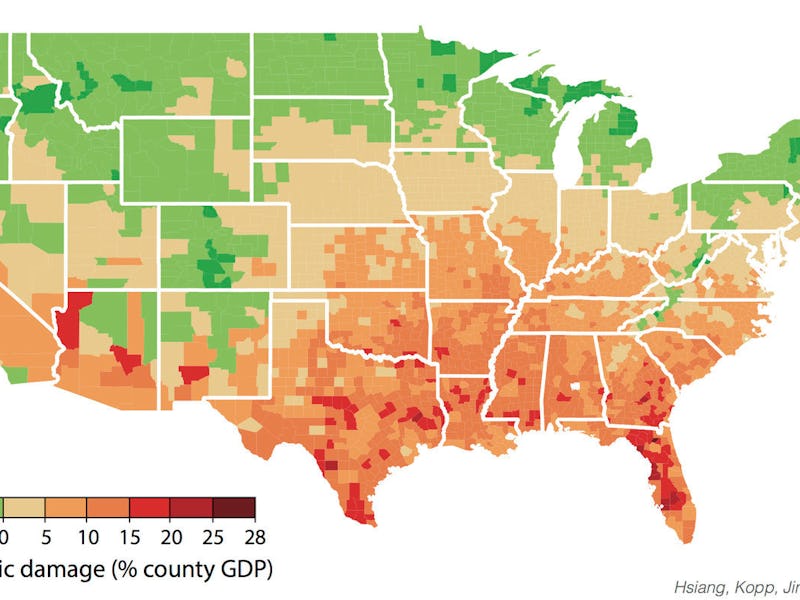Climate Change Will Shift U.S. Wealth From South to North
The poorest counties pay the highest price.

Most people can agree that climate change sucks, but it’s definitely going to suck more for certain people. A new analysis shows that the northern parts of the United States could actually rich off of the effects of climate change, assuming they don’t mind exploiting the fact that their fellow Americans further south will be economically devastated by the effects of a too-hot world.
The report, written by the University of California-Berkeley’s Solomon Hsiang, Ph.D. and co-authors, was published recently in Science. To come to their surprising conclusion, Hsiang and his team modeled the economic impacts of climate change at a county level across the contiguous U.S. They analyzed the costs of shifts in agriculture, labor, energy, and crime, among other indicators. What they found is that, while the U.S. stands to suffer overall, those costs will be borne predominantly by southern parts of the country, which tend to be worse off to begin with.
“Though it is intuitive in retrospect, I was surprised by the pattern of unequal climate impacts within the United States revealed by our analysis,” Robert Kopp, a professor of Earth sciences at Rutgers University and co-author of the report, tells Inverse by e-mail. “The co-incidence between warmth and poverty means climate change impacts will tend to be most harmful in areas that are already poor, causing them to amplify inequality.”
Climate change costs are uneven across the U.S.
By the end of this century, the worst-hit American counties could see 25 percent of their economies evaporate from the consequences climate change. Northern counties, on the other hand, could see gains of 10 percent or more, mostly due to increased agricultural yields, lower winter energy costs, and reduced mortality. That’s assuming a business-as-usual scenario, where very little effort is put toward limiting global greenhouse gas emissions.
But while northern parts of the country enjoy their milder winters, people in the South will literally be dying from heat.
“When we achieve really high temperatures, especially in the southern regions of the United States, we’re going to see many more people exposed to heat stress and suffer mortality in ways that society spends a lot of money to avoid, and that is going to be probably the biggest impact for the United States,” Hsiang, a professor of public policy with Berkeley, said in a press video.
Weather related deaths will go up in the South and down in northern parts of the U.S. This may be the most significant economic impact of climate change.
Limiting the impacts of global warming on inequality in the U.S. will require national programs that address those costs, says Kopp. “Much as flood insurance and disaster relief share costs nationally now, future policies might share the costs of coping with climate change impacts; if so, the contribution to inequality will be less, and the scale of government larger.”
The battle over who pays the costs of climate change will play out in the United States much as it does on the world stage. Without intervention, the rich cause most of the warming and the poor pay most of the price.
Abstract
Estimates of climate change damage are central to the design of climate policies. Here, we develop a flexible architecture for computing damages that integrates climate science, econometric analyses, and process models. We use this approach to construct spatially explicit, probabilistic, and empirically derived estimates of economic damage in the United States from climate change. The combined value of market and nonmarket damage across analyzed sectors—agriculture, crime, coastal storms, energy, human mortality, and labor—increases quadratically in global mean temperature, costing roughly 1.2% of gross domestic product per +1°C on average. Importantly, risk is distributed unequally across locations, generating a large transfer of value northward and westward that increases economic inequality. By the late 21st century, the poorest third of counties are projected to experience damages between 2 and 20% of county income (90% chance) under business-as-usual emissions (Representative Concentration Pathway 8.5).